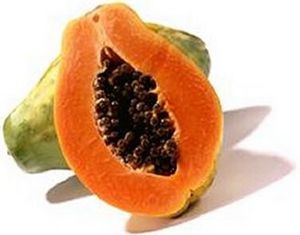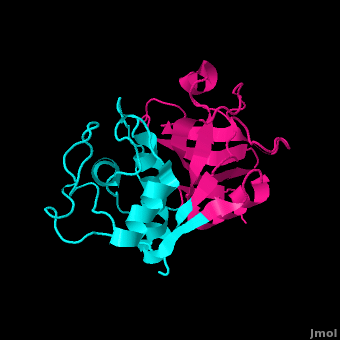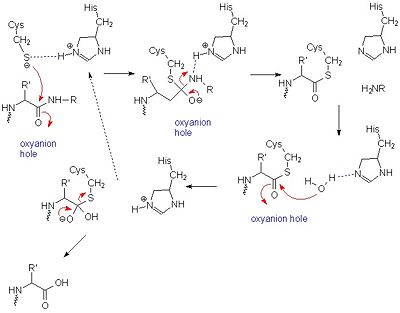Papain
From Proteopedia
| Line 41: | Line 41: | ||
In order to investigate binding of protein substrates to papain, Schröder et. al. crystallized the enzyme with the broad-spectrum competitive protease inhibitor leupeptin, shown in blue in the ribbon diagram. It has the structure Ac-Leu-Leu-Arginal, where Ac is an acetyl group attached to the nitrogen of the first leucine. The inhibitor functions by binding to the enzyme's active site, where the catalytic nucleophile (cysteine in papain) attacks the arginal aldehyde. This forms a tight-binding transition state from which the normal catalytic mechanism cannot proceed, due to this carbonyl having no potential leaving groups bonded to it. Analysis of the resulting structure revealed that the <scene name='9pap/Papain_sam_1popactivesite/1'>substrate binding pocket</scene> of papain consists primarily of a variety of <scene name='9pap/1pop_sam_leupeptin_hydrophobic/1'>hydrophobic residues</scene>, including tyrosine, tryptophan, and valine, which coordinate the bound leuptin. Some of the enzyme's residues also make <scene name='9pap/1pop_sam_leupeptin_hbonds/1'>hydrogen bonds</scene> with some of the leupeptin atoms. These hydrogen bonds, shown in yellow, include interactions between both hydrogens on both Gln-19 and the amide nitrogen of the catalytic Cys-25 with the arginal carbanion, forming the catalytically important oxyanion hole. In addition, Gly-66 interacts with the second leucine in leupeptin while Asp-158 interacts with a hydrogen on the arginal. These interaction further stabilize and orient the substrate in the binding pocket<ref name="Schroder">[http://www.sciencedirect.com/science/article/pii/001457939381128M] Schröder, E., C. Phillips, E. Garman, K. Harlos, C. Crawford. 1997. X-ray crystallographic structure of a papain-leupeptin complex. FEBS Letters 315: 38-42</ref>. | In order to investigate binding of protein substrates to papain, Schröder et. al. crystallized the enzyme with the broad-spectrum competitive protease inhibitor leupeptin, shown in blue in the ribbon diagram. It has the structure Ac-Leu-Leu-Arginal, where Ac is an acetyl group attached to the nitrogen of the first leucine. The inhibitor functions by binding to the enzyme's active site, where the catalytic nucleophile (cysteine in papain) attacks the arginal aldehyde. This forms a tight-binding transition state from which the normal catalytic mechanism cannot proceed, due to this carbonyl having no potential leaving groups bonded to it. Analysis of the resulting structure revealed that the <scene name='9pap/Papain_sam_1popactivesite/1'>substrate binding pocket</scene> of papain consists primarily of a variety of <scene name='9pap/1pop_sam_leupeptin_hydrophobic/1'>hydrophobic residues</scene>, including tyrosine, tryptophan, and valine, which coordinate the bound leuptin. Some of the enzyme's residues also make <scene name='9pap/1pop_sam_leupeptin_hbonds/1'>hydrogen bonds</scene> with some of the leupeptin atoms. These hydrogen bonds, shown in yellow, include interactions between both hydrogens on both Gln-19 and the amide nitrogen of the catalytic Cys-25 with the arginal carbanion, forming the catalytically important oxyanion hole. In addition, Gly-66 interacts with the second leucine in leupeptin while Asp-158 interacts with a hydrogen on the arginal. These interaction further stabilize and orient the substrate in the binding pocket<ref name="Schroder">[http://www.sciencedirect.com/science/article/pii/001457939381128M] Schröder, E., C. Phillips, E. Garman, K. Harlos, C. Crawford. 1997. X-ray crystallographic structure of a papain-leupeptin complex. FEBS Letters 315: 38-42</ref>. | ||
| + | ===Cathepsin K=== | ||
| + | The goal of research for the development of an inhibitor for <scene name='Sandbox_34/Cathepsink/1'>cathepsin K</scene> is the hope to develop a treatment for osteoporosis. In two different cathepsin K inhibitors, referenced PDB codes <scene name='Sandbox_34/Cathkaldinhibit/1'>1BP4</scene> and <scene name='Sandbox_34/Cathkketoinhibition/1'>1BQI</scene>, it is evident that the inhibitor binds with much closer proximity than that of Clik148. 1BP4 is a cathepsin K inhibitor, N-[(benzyloxy)carbonyl]-L-leucyl-N-[(2S)-1-hydroxy-4-methylpentan-2-yl]-L-leucinamide, that inhibits by interacting with 11 different residues on papain: Gln19, Gly20, Ser21, Gly23, Asn64, Gly65, Gln142, Asp158, His159, Trp177, and Trp181. These interactions range from hydrophobic, electrostatic, and hydrogen bonding, to <scene name='Sandbox_34/Cathkaldinhibitpistacking/2'>ring stacking</scene> between the aromatic ring of the carbobenzyl group on 1BP4, and TRP177 of papain. The inhibition of papain by IBQI, carbobenzyloxy-(L)-leucinyl-(L)leucinyl methoxymethylketone, is quite similar to that of IBP4, although it does not bind quite as tightly. It binds to seven residues of papain: Gln19, Gly23, Gly65, Gln142, His159, Trp177, Trp181. Additionally, it has similar | ||
| + | <scene name='Sandbox_34/Cathkketoinhibitionringstackin/2'>ring-stacking</scene> between the Cbz ring on the inhibitor and Trp 177, though it is more difficult to visualize with the given PDB file.<ref> PMID:9804696 </ref> | ||
==='''Cathepsin L (PDB ID #: 1CVZ)'''=== | ==='''Cathepsin L (PDB ID #: 1CVZ)'''=== | ||
Cathepsin L is another inhibitor of the papain enzyme. Cathepsin L interacts with the <scene name='Sandbox_31/Cathepl/1'>papain residues</scene> Gln19, Cys25, Gly66, Asp158, and Trp177 by hydrogen bonding them (Cathepsin L is lime green in the model, and the papain residues active in hydrogen bonding with Cathepsin L are highlighted with yellow halos). In addition to hydrogen bonding, hydrophobic interactions exist to exclude water, allowing the papain enzyme and Cathepsin L to associate even closer. Finally, <scene name='Sandbox_31/Stacking/1'>Ring Stacking</scene> between Trp177 and the Capthespin L molecule hold them tightly together.<ref>http://pubs.acs.org/doi/abs/10.1021/ci800085c</ref> Cathepsin L plays a roll in many different diseases including malaria, leishmaniasis, Chagas' disease, African trypanosomiasis, toxoplasmosis, and amoebiasis.<ref>http://www.ncbi.nlm.nih.gov/pmc/articles/PMC2923042/?tool=pubmed</ref>Some studies show that there is a relation between cathepsins and certain cancers, alzheimer's, and arthritis.<ref>http://www.biomedcentral.com/1472-6807/10/30</ref> | Cathepsin L is another inhibitor of the papain enzyme. Cathepsin L interacts with the <scene name='Sandbox_31/Cathepl/1'>papain residues</scene> Gln19, Cys25, Gly66, Asp158, and Trp177 by hydrogen bonding them (Cathepsin L is lime green in the model, and the papain residues active in hydrogen bonding with Cathepsin L are highlighted with yellow halos). In addition to hydrogen bonding, hydrophobic interactions exist to exclude water, allowing the papain enzyme and Cathepsin L to associate even closer. Finally, <scene name='Sandbox_31/Stacking/1'>Ring Stacking</scene> between Trp177 and the Capthespin L molecule hold them tightly together.<ref>http://pubs.acs.org/doi/abs/10.1021/ci800085c</ref> Cathepsin L plays a roll in many different diseases including malaria, leishmaniasis, Chagas' disease, African trypanosomiasis, toxoplasmosis, and amoebiasis.<ref>http://www.ncbi.nlm.nih.gov/pmc/articles/PMC2923042/?tool=pubmed</ref>Some studies show that there is a relation between cathepsins and certain cancers, alzheimer's, and arthritis.<ref>http://www.biomedcentral.com/1472-6807/10/30</ref> | ||
| - | |||
==='''Stefin B'''=== | ==='''Stefin B'''=== | ||
<scene name='Sandbox_36/Papain_inhibitor_space_fill/1'>Stefin B</scene> acts as a competitive inhibitor to cysteine proteases-- it binds tightly but reversibly to the papain active site. Stefin inhibitors are characterized by M<sub>r</sub> of about 11,000, no disulfide bonds and no associated carbohydrates. | <scene name='Sandbox_36/Papain_inhibitor_space_fill/1'>Stefin B</scene> acts as a competitive inhibitor to cysteine proteases-- it binds tightly but reversibly to the papain active site. Stefin inhibitors are characterized by M<sub>r</sub> of about 11,000, no disulfide bonds and no associated carbohydrates. | ||
| - | |||
In Stefin B, the Gly9 residue along with two hairpin loops form a "wedge" complementary to the active site groove of papain. This wedge makes extensive and tight interactions with papain and a total of 128 intermolecular atom-atom interactions occur. <scene name='Sandbox_36/Papain_inhibitor_wedge_involve/1'>Residue segments</scene> Met6-Pro11, Gln53-Asn59, Gln101-His104 and Tyr124-Phe125 on the wedge all have some interaction to the enzyme though not always direct. All residues from the base and both sides of the <scene name='Sandbox_36/Papain_inhibitor_activ_involve/1'>active site cleft</scene> are involved in the complex with the inhibtor (Trp177, Ser21, Cys63, Cys25, Asp158 and His159). | In Stefin B, the Gly9 residue along with two hairpin loops form a "wedge" complementary to the active site groove of papain. This wedge makes extensive and tight interactions with papain and a total of 128 intermolecular atom-atom interactions occur. <scene name='Sandbox_36/Papain_inhibitor_wedge_involve/1'>Residue segments</scene> Met6-Pro11, Gln53-Asn59, Gln101-His104 and Tyr124-Phe125 on the wedge all have some interaction to the enzyme though not always direct. All residues from the base and both sides of the <scene name='Sandbox_36/Papain_inhibitor_activ_involve/1'>active site cleft</scene> are involved in the complex with the inhibtor (Trp177, Ser21, Cys63, Cys25, Asp158 and His159). | ||
| Line 56: | Line 57: | ||
There are a small number of <scene name='Sandbox_36/Papain_inhibitor_direct_bond/2'>direct hydrogen bonds</scene> between stefin B and papain, however there are many more polar interactions mediated by <scene name='Sandbox_36/Papain_inhibitor_bridges_inter/1'>solvent bridges</scene>. Thirteen solvent molecules bridge polar residues of the enzyme and inhibitor. Seventeen hydrogen bonds are made with a solvent molecule and stefin. Fourteen of these bridges form a papain contact. The rest of the interactions are largely hydrophobic-- involving apolar <scene name='Sandbox_36/Papain_inhibitor_hydro_inter/2'>Van der Waals interactions</scene>. <ref> http://www.ncbi.nlm.nih.gov/pmc/articles/PMC551902/pdf/emboj00233-0254.pdf </ref> | There are a small number of <scene name='Sandbox_36/Papain_inhibitor_direct_bond/2'>direct hydrogen bonds</scene> between stefin B and papain, however there are many more polar interactions mediated by <scene name='Sandbox_36/Papain_inhibitor_bridges_inter/1'>solvent bridges</scene>. Thirteen solvent molecules bridge polar residues of the enzyme and inhibitor. Seventeen hydrogen bonds are made with a solvent molecule and stefin. Fourteen of these bridges form a papain contact. The rest of the interactions are largely hydrophobic-- involving apolar <scene name='Sandbox_36/Papain_inhibitor_hydro_inter/2'>Van der Waals interactions</scene>. <ref> http://www.ncbi.nlm.nih.gov/pmc/articles/PMC551902/pdf/emboj00233-0254.pdf </ref> | ||
| - | |||
| - | ===Clik-158=== | ||
| - | |||
</StructureSection> | </StructureSection> | ||
Revision as of 01:07, 5 April 2012

Papain belongs to an extended family of aminopeptidases, dipeptidyl peptidases, endopeptidases, and other enzymes having both exo- and endo-peptidase activity. The inactivated zymogen with N-terminal propeptide regions - providing stability in alkaline environments and enabling proper folding - is activated through removal of the propeptide regions. [2] The protein is primarily secreted with its pro-region enabling transport from zymogen to lysosome through membrane association and mediation. [3]
Papain. Meat tenderizer. Old time home remedy for insect, jellyfish, and stingray stings[4]. Who would have thought that a sulfhydryl protease from the latex of the papaya fruit, Carica papaya and Vasconcellea cundinamarcensis would have such a practical application beyond proteopedia?
Papain made its first appearance in the Calcutta Medical Journal entitled “The Solvent Action of Papaya Juice on Nitrogenous Articles of Food” when G.C Roy was investigating the enzyme in 1873. In the late 19th century, Wurtz and Bouchut dubbed the partially purified enzyme "papain." [5] At the time, it was viewed as a proteolytically active constituent in the latex of tropical papaya fruit. [6] As separation and purification techniques improved, pure papain was able to be isolated. In becoming the second enzyme to attain an X-ray crystallized structure and the first cysteine protease to behold an identifiable structure, papain fueled greater advances in enzymatic studies. [7]
Papain is a 23.4 kDa, 212 residue cysteine protease, also known as papaya proteinase I, from the peptidase C1 family (E.C. 3.4.22.2).[8][9] It is the natural product of the Papaya(Carica papaya)[10], and may be extracted from the plant's latex, leaves and roots. [11]. Papain displays a broad range of functions, acting as an endopeptidase, amidase, and esterase,[11] with its optimal activity values for pH lying between 6.0 and 7.0, and its optimal temperature for activity is 65 °C. Its pI values are 8.75 and 9.55, and it is best visualized at a wavelength of 278 nm. [10]
Papain's enzymatic use was first discovered in 1873 by G.C. Roy who published his results in the Calcutta Medical Journal in the article, "The Solvent Action of Papaya Juice on Nitrogenous Articles of Food." In 1879, papain was named officially by Wurtz and Bouchut, who managed to partially purify the product from the sap of papaya. It wasn't until the mid-twentieth century that the complete purification and isolation of papain was achieved. In 1968, Drenth et al. determined the structure of papain by x-ray crystallography, making it the second enzyme whose structure was successfully determined by x-ray crystallography. Additionally, papain was the first cysteine protease to have its structure identified.[11] In 1984, Kamphuis et al. determined the geometry of the active site, and the three-dimensional structure was visualized to a 1.65 Angstrom solution.[12] Today, studies continue on the stability of papain, involving changes in environmental conditions as well as testing of inhibitors such as phenylmethanesulfonylfluoride (PMSF), TLCK, TPCK, aplh2-macroglobulin, heavy metals, AEBSF, antipain, cystatin, E-64, leupeptin, sulfhydryl binding agents, carbonyl reagents, and alkylating agents.[11]
Contents |
Structure
| |||||||||||
Inhibitors
| |||||||||||
Common Uses
Medicinal
Papain has been used for a plethora of medicinal purposes including treating inflammation, shingles, diarrhea, psoriasis, parasites, and many others.[26] One major use is the treatment of cutaneous ulcers including diabetic ulcers and pressure ulcers.[27] Pressures ulcers plague many bed bound individuals and are a major source of pain and discomfort. Two papain based topical drugs are Accuzyme and Panafil, which can be used to treat wounds like cutaneous ulcers.[28]
A recent New York Times article featured papain and other digestive enzymes.[29] With the number of individuals suffering from irritable bowel syndrome and other gastrointestinal issues, many people are turning toward natural digestive aid supplements like papain. The author even talks about the use of papain along with a pineapple enzyme, bromelain, in cosmetic facial masks. Dr. Adam R. Kolker (a plastic surgeon) is quoted in the article saying that "For skin that is sensitive, enzymes are wonderful." He bases these claims off the idea that proteases like papain help to break peptide bonds holding dead skin cells to the live skin cells.[30]
Commercial and Biomedical
Papain digests most proteins, often more extensively than pancreatic proteases. It has a very broad specificity and is known to cleave peptide bonds of basic amino acids and leucine and glycine residues, but prefers amino acids with large hydrophobic side chains. This non-specific nature of papain's hydrolase activity has led to its use in many and varied commercial products. It is often used as a meat tenderizer because it can hydrolyze the peptide bonds of collagen, elastin, and actomyosin. It is also used in contact lens solution to remove protein deposits on the lenses and marketed as a digestive supplement. [31] Finally, papain has several common uses in general biomedical research, including a gentle cell isolation agent, production of glycopeptides from purified proteoglycans, and solubilization of integral membrane proteins. It is also notable for its ability to specifically cleave IgG and IgM antibodies above and below the disulfide bonds that join the heavy chains and that is found between the light chain and heavy chain. This generates two monovalent Fab segments, that each have a single antibody binding sites, and an intact Fc fragment.[11]
Fun Trivia
Remember the 2002 SARS (Severe Acute Respiratory Syndrome) epidemic that placed global health, particularly in Southeast Asia, in a precarious state? On-going research is happening to further understand the mechanisms of this coronavirus, so that future steps can be taken for prevention. Its been found that the replication of RNA for this virus is mediated by two viral proteases that have many papain-like characteristics. [32]
Despite a low percentage of sequence identities, inhibition and sequence analyses have increasingly been drawing parallels between L proteinases, that involve the foot-and-mouth disease virus and equine rhinovirus 1, and papain. With a similar overall fold to papain and identifiable regions that resemble the five alpha-helices and seven beta-sheets of papain, L proteinases of foot-and-mouth disease virus and of equine rhinovirus 1 reveal a mode of operation that is very papain like. [33]
References
- ↑ [1] Papaya's Nutrition Facts
- ↑ Rawlings ND, Barrett AJ. Families of cysteine peptidases. Methods Enzymol. 1994;244:461-86. PMID:7845226
- ↑ Yamamoto Y, Kurata M, Watabe S, Murakami R, Takahashi SY. Novel cysteine proteinase inhibitors homologous to the proregions of cysteine proteinases. Curr Protein Pept Sci. 2002 Apr;3(2):231-8. PMID:12188906
- ↑ [2] Ameridan International
- ↑ Menard and Storer 1998
- ↑ Wurtz and Bouchut 1879
- ↑ Drenth J, Jansonius JN, Koekoek R, Swen HM, Wolthers BG. Structure of papain. Nature. 1968 Jun 8;218(5145):929-32. PMID:5681232
- ↑ [3] Uniprot
- ↑ 9.0 9.1 [4] 9PAP PDB
- ↑ 10.0 10.1 [5] Sigma Aldrich
- ↑ 11.0 11.1 11.2 11.3 11.4 [6] Worthington
- ↑ 12.0 12.1 Kamphuis IG, Kalk KH, Swarte MB, Drenth J. Structure of papain refined at 1.65 A resolution. J Mol Biol. 1984 Oct 25;179(2):233-56. PMID:6502713
- ↑ [7] Jane S. Richardson
- ↑ [8] The Structure of Papain
- ↑ http://books.google.com/books?hl=en&lr=&id=fk1hbZdPTEgC&oi=fnd&pg=PA79&dq=aromatic+residues+in+papain&ots=L8SvlkQaZU&sig=xZ2l8kj52PD7DzuiAQ1zah0CU2M#v=onepage&q=aromatic%20residues%20in%20papain&f=false
- ↑ http://www.rcsb.org/pdb/explore/explore.do?structureId=9PAP
- ↑ http://www.sigmaaldrich.com/life-science/metabolomics/enzyme-explorer/analytical-enzymes/papain.html
- ↑ [9] University of Maine
- ↑ [10]Harrison, M.J., N.A. Burton, and I.H. Hillier. 1997. Catalytic Mechanism of the Enzyme Papain: Predictions with a Hybrid Quantum Mechanical/Molecular Mechanical Potential. J. Am. Chem. Soc. 119: 12285-12291
- ↑ [11] Schröder, E., C. Phillips, E. Garman, K. Harlos, C. Crawford. 1997. X-ray crystallographic structure of a papain-leupeptin complex. FEBS Letters 315: 38-42
- ↑ LaLonde JM, Zhao B, Smith WW, Janson CA, DesJarlais RL, Tomaszek TA, Carr TJ, Thompson SK, Oh HJ, Yamashita DS, Veber DF, Abdel-Meguid SS. Use of papain as a model for the structure-based design of cathepsin K inhibitors: crystal structures of two papain-inhibitor complexes demonstrate binding to S'-subsites. J Med Chem. 1998 Nov 5;41(23):4567-76. PMID:9804696 doi:10.1021/jm980249f
- ↑ http://pubs.acs.org/doi/abs/10.1021/ci800085c
- ↑ http://www.ncbi.nlm.nih.gov/pmc/articles/PMC2923042/?tool=pubmed
- ↑ http://www.biomedcentral.com/1472-6807/10/30
- ↑ http://www.ncbi.nlm.nih.gov/pmc/articles/PMC551902/pdf/emboj00233-0254.pdf
- ↑ http://www.webmd.com/vitamins-supplements/ingredientmono-69-PAPAIN.aspx?activeIngredientId=69&activeIngredientName=PAPAIN
- ↑ http://www.pbm.va.gov/Clinical%20Guidance/Drug%20Monographs/Papain%20Urea.pdf
- ↑ http://www.pbm.va.gov/Clinical%20Guidance/Drug%20Monographs/Papain%20Urea.pdf
- ↑ http://www.nytimes.com/2012/02/23/fashion/enzymes-once-sidelined-try-to-grab-the-spotlight.html
- ↑ http://www.nytimes.com/2012/02/23/fashion/enzymes-once-sidelined-try-to-grab-the-spotlight.html
- ↑ http://www.webmd.com/vitamins-supplements/ingredientmono-69-PAPAIN.aspx?activeIngredientId=69&activeIngredientName=PAPAIN
- ↑ Barretto N, Jukneliene D, Ratia K, Chen Z, Mesecar AD, Baker SC. The papain-like protease of severe acute respiratory syndrome coronavirus has deubiquitinating activity. J Virol. 2005 Dec;79(24):15189-98. PMID:16306590 doi:10.1128/JVI.79.24.15189-15198.2005
- ↑ Skern T, Fita I, Guarne A. A structural model of picornavirus leader proteinases based on papain and bleomycin hydrolase. J Gen Virol. 1998 Feb;79 ( Pt 2):301-7. PMID:9472614
Reference
- Wang J, Xiang YF, Lim C. The double catalytic triad, Cys25-His159-Asp158 and Cys25-His159-Asn175, in papain catalysis: role of Asp158 and Asn175. Protein Eng. 1994 Jan;7(1):75-82. PMID:8140097
- Kamphuis IG, Kalk KH, Swarte MB, Drenth J. Structure of papain refined at 1.65 A resolution. J Mol Biol. 1984 Oct 25;179(2):233-56. PMID:6502713
3D Structures of Papain
3LFY, 1KHP, 1KHQ, 1CVZ, 1BQI, 1BP4, 1PPN, 1PPP, 1PIP, 1POP, 1PE6, 9PAP, 1PPD, 1PAD, 2PAD, 4PAD, 5PAD, 6PAD- Carica papaya
3IMA - Colocasia esculenta
1STF - Homo sapiens
2CIO - Trypanosoma brucei
3E1Z - Trypanosoma cruzi
Page seeded by OCA on Tue Feb 17 04:20:31 2009
Proteopedia Page Contributors and Editors (what is this?)
Kirsten Eldredge, Jacinth Koh, Sara Kongkatong, Kyle Burch, Michal Harel, Joel L. Sussman, Elizabeth Miller, Samuel Bray, David Canner, Jaime Prilusky


